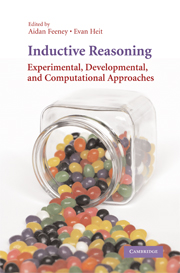Book contents
- Frontmatter
- Contents
- List of Figures
- List of Tables
- List of Contributors
- Preface
- 1 What Is Induction and Why Study It?
- 2 The Development of Inductive Reasoning
- 3 Interpreting Asymmetries of Projection in Children's Inductive Reasoning
- 4 Property Generalization as Causal Reasoning
- 5 Availability in Category-Based Induction
- 6 From Similarity to Chance
- 7 Theory-Based Bayesian Models of Inductive Reasoning
- 8 Use of Single or Multiple Categories in Category-Based Induction
- 9 Abductive Inference: From Philosophical Analysis to Neural Mechanisms
- 10 Mathematical Induction and Induction in Mathematics
- 11 Induction, Deduction, and Argument Strength in Human Reasoning and Argumentation
- 12 Individual Differences, Dual Processes, and Induction
- 13 Taxonomizing Induction
- Index
3 - Interpreting Asymmetries of Projection in Children's Inductive Reasoning
Published online by Cambridge University Press: 26 February 2010
- Frontmatter
- Contents
- List of Figures
- List of Tables
- List of Contributors
- Preface
- 1 What Is Induction and Why Study It?
- 2 The Development of Inductive Reasoning
- 3 Interpreting Asymmetries of Projection in Children's Inductive Reasoning
- 4 Property Generalization as Causal Reasoning
- 5 Availability in Category-Based Induction
- 6 From Similarity to Chance
- 7 Theory-Based Bayesian Models of Inductive Reasoning
- 8 Use of Single or Multiple Categories in Category-Based Induction
- 9 Abductive Inference: From Philosophical Analysis to Neural Mechanisms
- 10 Mathematical Induction and Induction in Mathematics
- 11 Induction, Deduction, and Argument Strength in Human Reasoning and Argumentation
- 12 Individual Differences, Dual Processes, and Induction
- 13 Taxonomizing Induction
- Index
Summary
INTRODUCTION
Like adults, children use categories as a basis for inductive inference. Having learned that some property is true of some individual (e.g., “My dog, Magic, likes marshmallows”), a child might assume both that other members of the same category (dogs) share this property and that members of other, similar categories (e.g., cats) might also share this property. In short, inductive inference may be guided by and reflect categorical relationships, hence the term “category-based induction” or CBI. Cognitive and developmental researchers have used a category-based induction paradigm not only to study the use of categories in reasoning, but also to draw inferences from patterns of reasoning about the nature of conceptual structures themselves (Atran et al., 2001; Carey, 1985; Gelman & Markman, 1986; Gutheil, Bloom, Valderrama, & Freedman, 2004; Gutheil, Vera, & Keil, 1998; Hatano & Inagaki, 1994; Inagaki, 2002; Johnson & Carey, 1998; Medin & Smith, 1981; Ross, Medin, Coley, & Atran, 2003; Waxman, Lynch, Casey, & Baer, 1997).
One of the most influential examples of the use of inductive projections to draw inferences about conceptual organization comes from research in the domain of folk biology involving categories of living things, including humans, nonhuman animals, and plants. Developmental evidence has revealed, in particular, certain systematic asymmetries in inductive strength among these categories. For example, researchers have found that children are more willing to project properties from humans to dogs than from dogs to humans.
- Type
- Chapter
- Information
- Inductive ReasoningExperimental, Developmental, and Computational Approaches, pp. 55 - 80Publisher: Cambridge University PressPrint publication year: 2007
- 7
- Cited by

